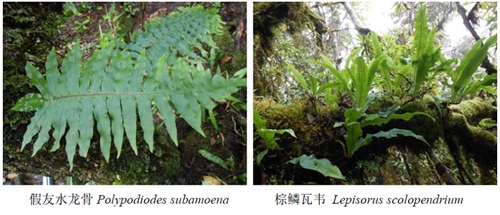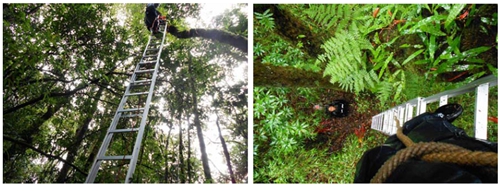Almost all epiphytic bryophytes and lichens and many vascular epiphytes are capable of clonal growth, However, little is known about how physiological integration facilitates adaptation of epiphytes to forest canopies.
In a previous study, Prof.LIU Wenyao’s team of Xishuangbanna Tropical Botanical Garden (XTBG) selected one clonal, facultative, epiphytic fern to test effects of physiological integration in both epiphytic and terrestrial habitats in the dry season in a subtropical montane moist forest. They found that clonal integration contributed greatly to survival and growth of a clonal, facultative, epiphytic fern. However, it is still unknown whether clonal integration also plays an important role in dominant epiphytes and during the wet season.
The researchers further conducted two field experiments,one on individuals (single ramets) and another on groups (several ramets within a plot), with severed and intact rhizome treatments (without and with physiological integration), on two dominant epiphytes (Polypodiodes subamoena and Lepisorus scolopendrium) with divergent traits in a wet season in a subtropical montane moist forest in Southwest China. They aimed to test whether clonal integration was a general strategy for clonal epiphytes to adapt to forest canopies. They asked whether clonal integration increased survival and growth of dominant epiphytes during the wet season when water stress was seemingly weak. They then asked whether the effect of clonal integration on survival and growth differed between the two epiphytes with divergent traits.
Both individual and group experiments showed that severing rhizomes decreased survival and growth of the two dominant epiphytic ferns in the wet season, supporting the hypothesis that clonal integration (resource sharing) contributed to performance of epiphytes. The results indicated that clonal integration (resource sharing) may have been selected for as a general trait for clonal epiphytes to adapt to the harsh and heterogeneous epiphytic habitats.
The study entitled “Survival and Growth of Epiphytic Ferns Depend on Resource Sharing” has been published in Frontiers in Plant Science.
Contact
Prof. LIU Wenyao, Ph.D Principal Investigator
Key Laboratory of Tropical Forest Ecology, Xishuangbanna Tropical Botanical Garden, Chinese Academy of Sciences, Mengla, Yunnan 666303, China
Tel: 86-871-65153787
E-mail: liuwy@xtbg.ac.cn

Two dominant epiphytic ferns in forest canopies (Images by LU Huazheng) 
Field study (Images by LU Huazheng) |


